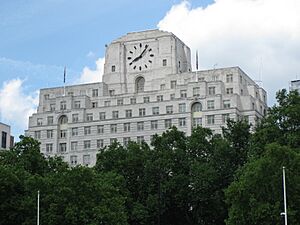Pearson plc facts for kids
 |
|

Eighty Strand, Pearson's headquarters in London
|
|
|
Formerly
|
S. Pearson & Son |
|---|---|
| Public | |
| Traded as | |
| Industry |
|
| Founded | 1844 |
| Founder | Samuel Pearson |
| Headquarters | Shell Mex House, London, England |
|
Key people
|
|
| Products | Educational materials (books, tests), Television distribution |
| Services |
|
| Revenue | |
|
Operating income
|
|
| Total assets | |
| Total equity | |
|
Number of employees
|
17,612 (2023) |
| Subsidiaries |
|
Pearson plc is a huge British company that focuses on creating books, tests, and other tools for education. You might know it as the company that owns Edexcel, one of the main boards for GCSE exams in the UK.
But Pearson wasn't always an education company. It started way back in 1844 as a small building business in Yorkshire, England, called S. Pearson & Son. Over many years, it grew into a massive company that owned businesses in many different areas, like oil, banking, and newspapers.
After World War II, the company began to focus more on publishing. By 2016, Pearson had sold off its other businesses to focus completely on education. Today, its main goal is to help people learn all over the world.
Contents
Company History
From Building to a Global Giant
The Pearson company began in 1844 when Samuel Pearson joined a small building and brick-making business. His grandson, Weetman Pearson, took over in 1880. Weetman was a talented engineer who turned the small family business into one of the world's largest construction companies.
The company built amazing things all over the globe, including:
- The Blackwall Tunnel under the River Thames in London.
- Tunnels for railways under the East River in New York City.
- A huge canal to drain Mexico City.
- Railways and harbors in Mexico and other countries.
The construction part of the company closed down in the 1920s after completing major projects like a dam in Sudan.
A Company of Many Businesses
For much of the 20th century, Pearson was a conglomerate, which is a giant company that owns many smaller companies in different industries. Besides construction, Pearson was involved in:
- Manufacturing: It owned companies that made pottery and fine china, like Royal Doulton.
- Oil: Weetman Pearson discovered oil in Mexico and started the successful Mexican Eagle Petroleum Company.
- Banking: The company owned a large part of the famous merchant bank Lazard.
- Newspapers: In 1957, Pearson bought the Financial Times newspaper and a 50% share in The Economist magazine.
Over time, Pearson sold most of these businesses to focus on what it does best today.
Becoming a Publishing Powerhouse
Pearson's journey into education and media began seriously in the mid-20th century.
In 1968, it bought the publisher Longman. This was a big step into the world of books. A few years later, in 1970, it bought the famous paperback publisher Penguin Books. In 1972, it added the popular children's publisher Ladybird Books to its collection.
During the 1990s, Pearson also got into the television business. It bought several TV production companies, including Thames Television, which used to be part of the ITV network in the UK. However, by 2002, it had sold its TV businesses to focus more on publishing.
Focusing on Education
The biggest change for Pearson happened in the late 1990s and early 2000s. The company decided to make education its main focus.
In 1998, Pearson bought the education part of a company called Simon & Schuster. It combined this with its other education publishers, like Longman, to create Pearson Education.
Over the next few years, Pearson bought many more education-related companies:
- Dorling Kindersley (DK): The publisher of popular illustrated reference books, bought in 2000.
- Edexcel: A major UK exam board, bought in 2003. This made Pearson a key player in UK school qualifications like GCSEs and A-Levels.
- Assessment Companies: It bought several companies in the U.S. that create and score tests for schools.
To show its new focus, the company changed the name of Pearson Education to just Pearson in 2011.
Becoming a Pure Education Company
By 2015, Pearson was ready to go all-in on education. That year, it sold the Financial Times newspaper and its share in The Economist magazine.
In 2016, the company officially announced it was now focused only on education. It even adopted a new logo: the interrobang (‽). This symbol, a mix of a question mark and an exclamation point, was chosen to show the excitement and curiosity of learning.
Since then, Pearson has continued to adapt to the modern world of learning. It sold its remaining share in the book publisher Penguin Random House in 2019. It now focuses heavily on digital learning, online courses, and educational technology. In 2022, it bought Mondly, an online language-learning platform.
Today, Pearson is led by CEO Omar Abbosh and continues to create educational materials and services for students and teachers worldwide.
What Pearson Does Today
Pearson plc is a holding company, which means it owns other companies that do the actual business. Its main work is divided into several areas:
- Assessment & Qualifications: This includes creating and marking exams, like those from Edexcel.
- Virtual Learning: Providing online schools and tutoring for students from kindergarten through high school.
- English Language Learning: Offering courses and tests for people learning English as a second language.
- Workforce Skills: Training and courses to help people get skills for jobs.
- Higher Education: Creating textbooks, e-books, and online learning tools for university students.
See also
 In Spanish: Pearson PLC para niños
In Spanish: Pearson PLC para niños
- Bertelsmann
- Elsevier
- Holtzbrinck Publishing Group
- Lagardère Publishing
- McGraw Hill Education
- News Corp
- Scholastic Corporation
- Thomson Reuters
- Wiley (publisher)

